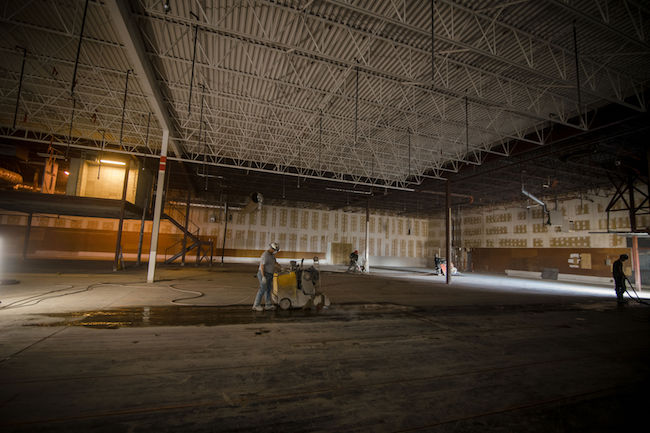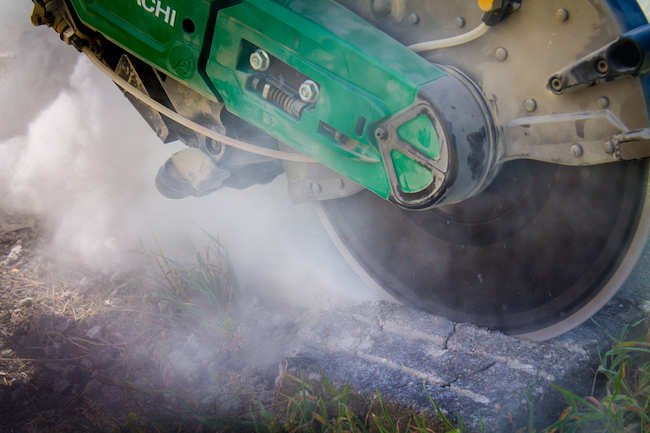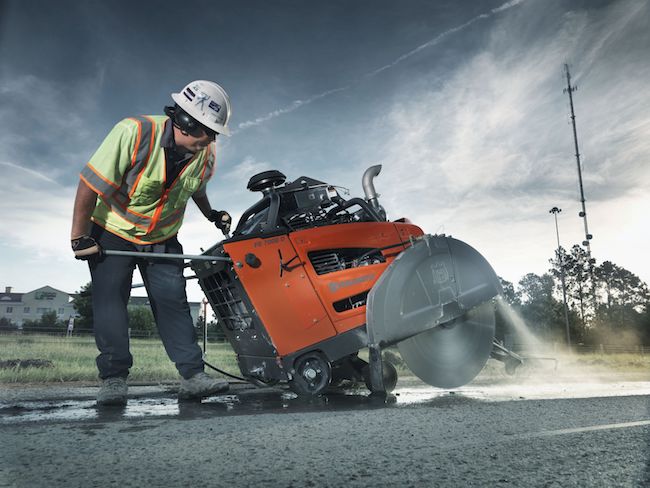
Drilling down: Concrete cutting and coring equipment advances on the job site
By Jillian Morgan
Concrete Equipment
Concrete cutting and coring are essential at some stage of most construction projects. PHOTO: Derrick Concrete Cutting and Construction Ltd./Jillian Ila Photography
Scarcely any structure can be built without concrete, leaving no shortage of work for the crews that cut, core and demolish the ubiquitous building material on a diversity of job sites.
The labour-intensive process is necessary to deliver most projects, says Paul Murtagh, cutting manager at Alberta-based Derrick Concrete Cutting and Construction Ltd.
“There’s just a lot of things you cannot do without concrete cutting or coring,” he says. “Especially with changes in renovations to older buildings and stuff, you have to have concrete cutting involved or you’d have to break everything up and try to redo everything. It saves a lot of costs for general contractors.”
Continual repair contracts for concrete infrastructure such as bridge decks and piers fuel the demand, too, says Paul De Berardis, the director of building science and innovation at the Residential Construction Council of Ontario (RESCON).
“Reinforced concrete is one of the most common and prevalent materials in all different forms of construction, whether it be building construction, infrastructure [or] transportation,” he says. “The fact that it can be repaired and brought back to like-new condition is why you have such a high need for cutting, coring and concrete drilling.”
Though concrete itself has gone largely unchanged, the tools used to cut and core concrete have steadily evolved, enabling contractors to deliver on those projects faster and safer.
Corey Saban, vice-president of Derrick Concrete, says the company often invests in new equipment. “Staying current is pretty important to us so we can provide the best service that we can,” he says.
“We definitely rely on suppliers to help us with equipment and let us provide the innovation with the resources on figuring out how to cut this certain square footage most efficiently.”
ON THE JOB
The tools used to cut and drill tough concrete largely depend on the application.
Delaminating and spalling concrete in a parking garage, for example, could call for contractors to chip off the surface or perform a full depth slab replacement, De Berardis says. Loose concrete on a deteriorating bridge deck, on the other hand, may need to be broken off and replaced; coring can be performed to test the condition of the concrete.
Sawing window and door openings or coring holes for piping on new builds and renovation projects are also a significant part of the job.
“In slow economic times like we’re in, [there’s] a lot of renovation work. Lots of existing buildings are being modified,” Saban says. “A new tenant will come in and they’ll have different mechanical or electrical requirements, they’ll have different door openings.”
Green cutting freshly poured concrete to prevent slab cracking and diamond slab-sawing concrete for curb removal projects are other services offered by Derrick Concrete. For large-scale road resurfacing or utility installation, the team will use a Vermeer Wheel Cutter, capable of cutting depths up to 787 millimetres (31 inches).
“It’s beneficial for neighbourhood renewals or city expansion plans,” Saban says. “We can get the Vermeer in there and cut up a section of road and then they can run their utilities in there. For rehab projects, it’s a really good piece of equipment.”
To precisely cut and remove sizeable chunks of concrete, Derrick Concrete crews opt for diamond wire saws, says Cutting Operations Manager Ryan Chamberlin.
“Run [it] through at high speed and apply steady pressure and it will cut through large sections at a time,” he says.
Michael Cace, northeast regional sales manager for Bartell Global’s Construction Equipment Group, says diamond blades and core bits have “moved into the commodity category” over the last 30 years.
“This is really not a negative thing. Prices have come down significantly because of the supply side. However, lower prices and selection have made concrete cutting more affordable,” he says. “Lower pricing has opened the door for more contractors to benefit from diamond tooling technology.”
Bartell Global offers diamond tools to suit a number of applications, such as sawing standard concrete blocks, concrete bridge decks or asphalt over concrete. With so many options, Cace says contractors should know what they’re looking for – whether it’s speed, longevity or price.

The Samurai II diamond blade, available from Bartell Global, has a ribbed core to reduce friction and keep superior tension, even when cutting at full depth. The t-segments work to pull the blade into the cut, rather than having to push it. PHOTO: Bartell Global
“Price usually can be a good measure of quality. However, a good operator is just as important,” he says. “Also, a contractor needs to know the right application or what specific material the diamond blade is cutting. If not, the wrong application will have significant consequences resulting in poor performance and safety issues.”
While the latest equipment can help contractors work more efficiently, concrete cutting and coring crews can run into a number of setbacks on the job.
“Jobs can change as you’re doing them,” Murtagh says. “You can run into different issues.”
One key trend saving contractors time is servicing agreements, says Mark Michaels, director of product management for Equipment, at Husqvarna. Through the company’s Upcare program, contractors can monitor and proactively maintain equipment. When a product fails, contractors can access priority repair services or loaner equipment.
“Any time a machine is down, it’s costing them money in one way or another… They’re looking for different solutions to keep their equipment in the field and there are a lot of them,” he says. “The big one that’s growing rapidly is service-type agreements where you can own a product or lease a product and have a pretty good programmer guarantee that if that product goes down, you either have priority for getting it repaired or, depending on the piece of equipment, it could be a loaner to keep you up and running.”
DRIVING PERFORMANCE
Though safety focused developments – mainly around protecting workers from silica dust exposure – have played no small role, there are a number of other trends driving the evolution of cutting and drilling equipment.
“Performance is still the master,” Michaels says. “People will always gravitate towards performance if everything else is equal, because that’s where they’re going to make their money.”
At Derrick Concrete, crews have a range of tools to suit the needs of any particular job, such as hydraulically powered wall saws, electric handsaws and pneumatic diamond core drilling machines. For the demolition projects it takes on, the contractor uses the Brokk line of electric remote breakers that can complete jobs without putting workers at risk.
The shift from hydraulic and diesel equipment to electrical products marks a major development, Michaels says. Husqvarna’s PRIME line of high performance electric cutting equipment is one such technology. The range offers chainsaws, ring saws, wall saws and drill motors, to name a few.

The FS 7000 D diesel walk-behind floor saw from Husqvarna features ergonomic controls and electronic support systems. It is available with single speed or three-speed gearbox, as well as an electronic tracking system on the rear axle. PHOTO: Husqvarna
“We can make very, very powerful equipment that has the extra features of being much, much lighter and more controllable and safer in some instances,” Michaels says. “It’s the same type of technology that can drive both, and that’s kind of the beauty of it.”
Electric equipment can also enhance ergonomics, Michaels says. Husqvarna’s PRIME products, for example, offer features that reduce strain for the operator, such as low weight and optimally positioned handles.
“You can have two products that both weigh 20 pounds and one is kind of hard to lift and carry around and the other one is very easy due to ergonomics,” Michaels says. “For owners or the buyers… Ergonomics is a harder thing for them to put a dollar sign on. They’re often looking at safety features, so we also concentrate on the more obvious types of safety features with different guarding and being able to control the blade speed in various ways.”
This article first appeared in the August 2019 issue of On-Site. Click here to read through the full issue.




